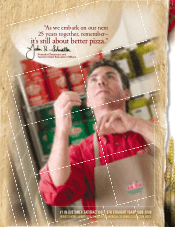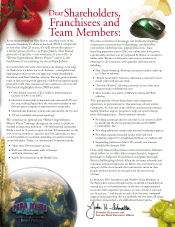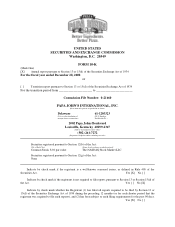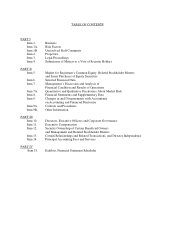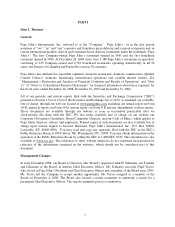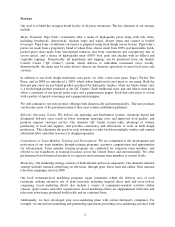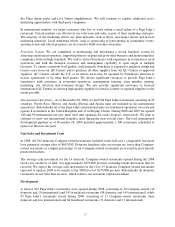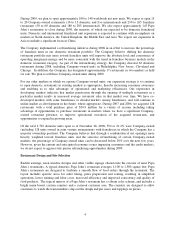Papa Johns 2008 Annual Report Download - page 13
Download and view the complete annual report
Please find page 13 of the 2008 Papa Johns annual report below. You can navigate through the pages in the report by either clicking on the pages listed below, or by using the keyword search tool below to find specific information within the annual report.6
to restaurants by refrigerated trucks leased and operated by us or transported by a dedicated logistics
company.
PJ Food Service, Inc. (“PJFS”), our wholly owned subsidiary that operates our domestic Company-
owned QC Centers, has a purchasing arrangement with BIBP Commodities, Inc. (“BIBP”), a third-party
entity formed by franchisees for the sole purpose of reducing cheese price volatility to domestic system-
wide restaurants. Historically, under this arrangement, PJFS purchased cheese from BIBP at a fixed
quarterly price based in part on historical average cheese prices. Gains and losses incurred by BIBP are
passed to the QC Centers and Company-owned and franchise restaurants through adjustments to the
selling price. Over time, PJFS purchases cheese at a price approximating the actual average market price,
but with more predictability and less price volatility. As a result of margin pressures in late third quarter
and early fourth quarter 2008, a reduction in cheese pricing to restaurants was implemented in Period 11
(“Q4-08 modified price”). See “Management’s Discussion and Analysis of Financial Condition and
Results of Operations – Consolidation of BIBP Commodities, Inc. (“BIBP”) as a Variable Interest
Entity,” and “Note 4” of “Notes to Consolidated Financial Statements” for additional information
concerning BIBP and the purchasing arrangement, and the related financial statement treatment of
BIBP’s results.
Marketing Programs
All domestic Company-owned and franchised Papa John’s restaurants within a defined market are
required to join an area advertising cooperative (“Co-op”). Each member restaurant contributes a
percentage of sales to the Co-op for market-wide programs, such as radio, television and print
advertising. The rate of contribution and uses of the monies collected are determined by a majority vote
of the Co-op’s members (in most cases the contribution rate cannot be below 2.0% without approval from
Papa John’s). The restaurant-level and Co-op marketing efforts are supported by print and electronic
advertising materials that are produced by the Papa John’s Marketing Fund, Inc., a non-profit corporation
(the “Marketing Fund”). The Marketing Fund produces and buys air time for Papa John’s national
television commercials, in addition to other brand-building activities, such as consumer research and
public relations activities. All domestic Company-owned and franchised Papa John’s restaurants are
required to contribute a certain percentage of sales to the Marketing Fund. The contribution rate to the
Marketing Fund can be increased above the required contribution rate if a majority of the domestic
restaurants agree to such increase. The contribution percentage was 2.7% during 2008 and 2007 and
2.6% during 2006. The contribution percentage to the Marketing Fund is currently set at 2.7% for the
first three months of 2009 and 2.82% for the remainder of the year.
Restaurant-level marketing programs target the delivery area of each restaurant, making extensive use of
targeted print materials including direct mail and store-to-door couponing. The local marketing efforts
also include a variety of community-oriented activities with schools, sports teams and other
organizations. In markets in which Papa John’s has a significant presence, local marketing efforts are
supplemented with local radio and television advertising.
We provide both Company-owned and franchised restaurants with pre-approved print marketing
materials and with catalogs for the purchase of uniforms and promotional items. We also provide direct
marketing services to Company-owned and franchised restaurants using customer information gathered
by our proprietary point-of-sale technology (see “Company Operations – Point of Sale Technology”).
We have developed joint cross-marketing plans with certain third-party companies. For example, in 2006
we entered into a five-year marketing and partnership agreement with Six Flags theme parks and in 2007,
we entered into a four-year agreement with Live Nation amphitheaters. Both agreements provide for


